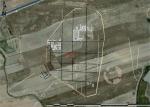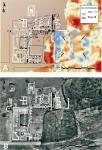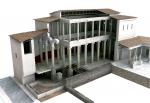Summary (English)
Research (2007-2014)
City mentioned by Pliny (NH III, 13-14) Contributa Iulia was located in the Baeturia Celtic region, province of Baetica, in the Conventus Hispalensis. It has been suggested that the origin of the city may come from a phenomenon , Contributio, which gathered nearby settlements around the management of a single administrative center. This seems to be indicated by the archaeological’s remains, where the public character dominates in a city of small dimensions.
Following the results of a large number of studies made at the site – geophysical surveys, geomagnetic, interpretation of aerial photographic interpretation and different archaeological’s excavations – we have been able to define a city around 5-6 hectares, situated on a hill (Los Cercos) in Medina de Las Torres, Badajoz.
Until the mid-nineteenth century the site was almost unknown, it was a local historian, J. A. Barrientos, the first who recovered archaeological’s objects, so initially the place was the focus of historical interest. Among the pieces found in the early works in 1845, the Archaeological Museum of Badajoz currently preserves robed sculptures.
Since 2007, the Institute of Archaeology in Merida, has conducted different research activities and systematic archaeological excavations in the site with the cooperation of the town council and the regional Government of Extremadura. The results of our interventions have characterized different urban areas.
These include the definition of one of the gates of the city to the west, with a salient flanked by rectangular towers and the presence of a stretch of wall stretch made with a base of stone and elevations of pisé de terre. A guard post, with a well_preserved fountain, is related to the management of the entrance door and characterized by the presence of long benches against the walls. This space is situated at an intersection of streets that facilitated the recognition of the urban development for this area and helped us to define the citiy grid. The first visible zone is characterized by the presence of a commercial area with tabernae and production, or storage places around a central courtyard.
The highest part of the city is occupied by a forum with a small square, a portico in the southern side is overlap with a series of tabernae and temples, and a well-preserved large basilica characterized by the presence of a cryptoporticus with three aisles and an apse on the south side.
The north part of the forum shows other structures still under study, the most notably is the presence of a possible association headquarters, probably related to Minerva, because of the abundant number of fragments of votive statuettes alluding to the goddess recovered in the environment.
In the southern part of the city was discovered in recent archaeological excavations an small tetrastyle urban sanctuary defined by a central temple, an enclosure and a well, where an altar dedicated to Fontano and Fontilis was found. The same archaeological season revealed to the of the sanctuary, the first structures associated with the presence of a previously unknown amphitheater, built with a masonry foundation and an elevation in pisé de terre.
(translation by Esther Casares Carmona)
- Pedro Mateos Cruz y Antonio Pizzo
Director
- Antonio Pizzo (Instituto de Arqueología-Mérida – CSIC)
- Pedro Mateos (Instituto de Arqueología-Mérida – CSIC)
Team
- Antonio Peña
- Victorino Mayoral
- Ángel Ventura
- Antonio Pizzo (Instituto de Arqueología-Mérida – CSIC)
- Jesús Alonso
- Myriam García
- Pedro Delgado
- Pedro Mateos (Instituto de Arqueología-Mérida – CSIC)
- Tomás Cordero
- Macarena Bustamante
Research Body
- Instituto de Arqueología-Mérida, CSIC
Funding Body
- Consejería de Educación y Cultura del Gobierno de Extremadura; Dirección General de Patrimonio; Ayuntamiento de Medina de Las Torres






![Download [PDF]](/excavation/skins/fasti/images/results/download_sml.png)


